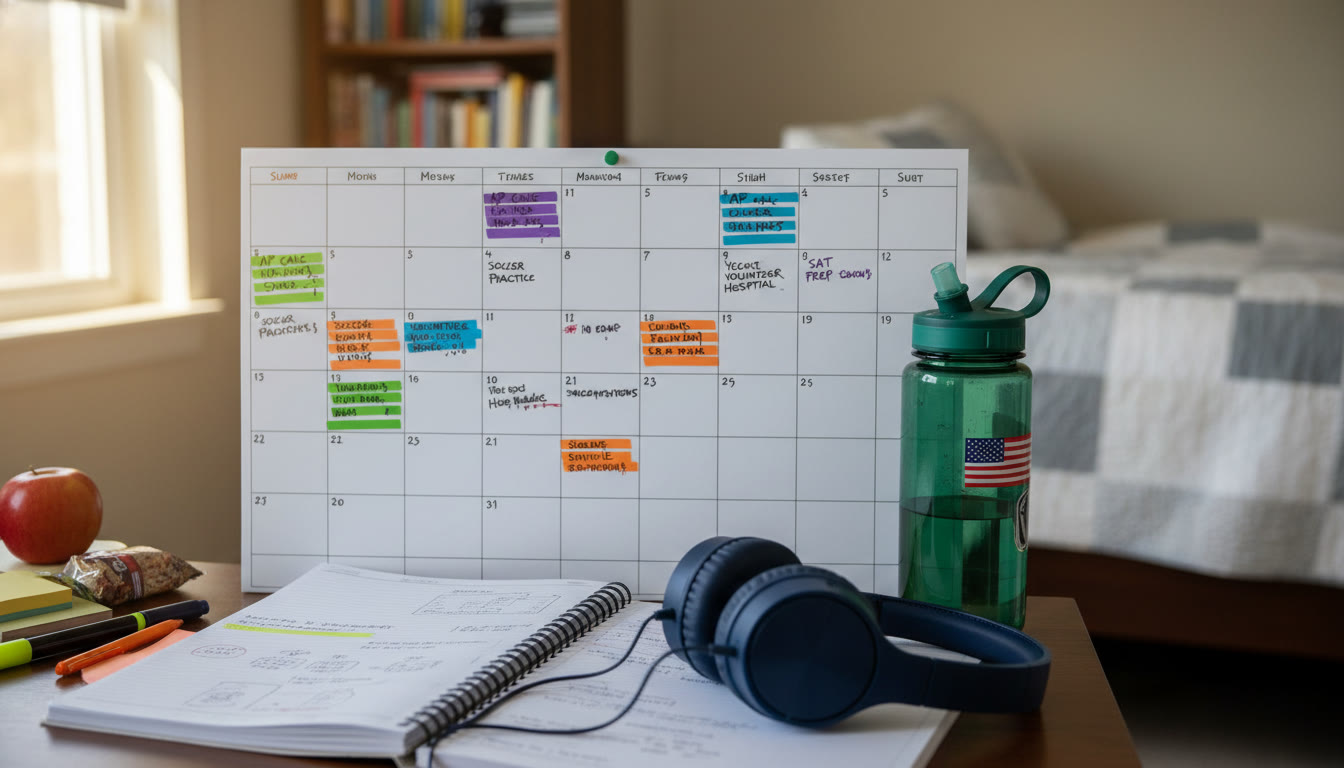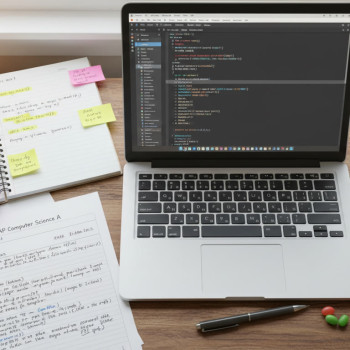Why Scheduling APs with Heavy Extracurriculars Feels Impossible (But Isn’t)
Raise your hand if you’ve ever sat in a team meeting, music rehearsal, or math circle and thought: “How am I supposed to add AP Calculus to this?” You’re not alone. The reality for driven high schoolers is this: advanced academics and intense extracurriculars often collide. The good news is that many students thrive while doing both—what changes is strategy, not sacrifice.

What “Heavy” Really Means
Not all extracurricular commitments are created equal. There’s a big difference between volunteering a few hours a week and being a varsity athlete with daily practices, overnight competitions, or an orchestra member preparing for a season of concerts. Similarly, an Olympiad participant may face intense weekly problem sets and travel for regional contests. When we say “heavy,” we mean commitments that regularly demand multiple evenings a week, weekend time, or travel.
The Mindset Shift: Quality Over Quantity
When your calendar is full, the number of APs you take matters less than which APs you choose and how you prepare for them. Admissions officers and scholarship committees will notice sustained depth—leadership in a sport, years of music study, or advancement in Olympiads—over a transcript that simply lists many AP course titles without consistent performance. That’s the first relief: you don’t need to take the most APs on your block to be competitive. You need to take the right ones, do well, and grow.
Step-by-Step Guide: Build a Schedule That Honors Both Goals
Below is a practical, realistic approach you can use right now to craft a schedule that supports AP success without burning out.
1. Audit Your Current Time
Start with a two-week time log. Track classes, practices, rehearsals, workouts, travel, sleep, homework, and downtime. Don’t estimate—write it down in 30–60 minute blocks. The exercise is eye-opening: it reveals pockets of time you didn’t realize you had and exposes genuine scheduling conflicts.
2. Rank Your Priorities
Make three columns: Must-Have, Nice-to-Have, and Drop-or-Defer. Include both activities (e.g., varsity soccer) and academic goals (e.g., AP Biology senior year). Being honest here is crucial. If you plan to pursue music at the college level, that might stay in Must-Have even if it takes more time.
3. Align AP Choices with Long-Term Goals
Which APs align with the major, campus credit, or skillset you want? Some subjects are foundational for specific majors (e.g., AP Calculus for engineering; AP Biology for pre-med; AP English for humanities). Choose APs that serve clear academic or college-credit purposes, not just prestige.
4. Use Academic Sequencing
Spread out science and math APs across years so exam season isn’t overloaded. For example:
- Junior Year: AP Language or AP US History + AP Science or AP Math (one major AP)
- Senior Year: AP Literature or a second Humanities AP + AP Science/Math continuation
This pattern keeps heavy-content exams from stacking in the same May.
5. Build Buffer Zones
Leave at least one “light” semester around peak extracurricular seasons—tournament season, audition season, or Olympiad training blocks. If your fall is packed with competitions, aim to take fewer APs that semester and shift a course to spring or the following year.
Practical Schedules: Three Model Plans
Below are model plans for common archetypes. Use them as templates and tweak based on your actual weekly hours and travel demands.
| Student Type | Typical Week | AP Load (Yearly) | Tips |
|---|---|---|---|
| Varsity Athlete (seasonal travel) | Daily practices 2–3 hrs, weekends travel | 1–2 major APs per semester | Front-load challenging APs in off-season; use AP Classroom for flexible review |
| Dedicated Musician (ensemble + individual practice) | Daily practice 1–2 hrs, rehearsals weekly | 2–3 APs per year, avoid triple-stack in exam May | Schedule solo practice earlier; plan lighter AP workload around audition season |
| Olympiad Competitor (math/science) | Weekly problem sets, weekend meets, summer camps | 1–2 APs per semester, focus on depth | Align APs with Olympiad focus (e.g., AP Calculus if math olympiad); schedule exam prep around contest calendar |
Example: A Realistic Junior Year
Consider a junior who plays varsity soccer (daily practice, weekend games) and competes in math olympiads.
- Core classes: English, US History, Chemistry (AP or honors), Precalculus
- APs: AP Chemistry (year-long) and AP English Language (year-long)
- Why it works: Soccer season in fall with heavy travel—AP Chemistry labs can be manageable if lab reports are scheduled during home weeks; AP English assignments are portable and can be completed on the bus.
Study Strategies That Respect Your Time
With less weekend and evening time, you must study smarter. Below are evidence-backed strategies to get more learning for each hour you commit.
Micro-Study Sessions Over Marathon Nights
Short, focused study blocks (25–45 minutes) with a single objective beat unfocused long sessions. If you have a 40-minute gap between rehearsal and dinner, use it for a targeted task: one AP Chemistry concept, one FRQ practice, or one passage in AP Bio.
Prioritize High-Leverage Tasks
Identify the tasks that produce the biggest score improvements: practice FRQs for AP History and AP Sciences, problem sets for AP Calculus, and timed essays for AP English. Make a weekly checklist and guard these items like practices or rehearsals.
Use the Calendar Like an Ally
Block your time—not just tasks but moods. Label slots as “Deep Work,” “Travel Study,” or “Rest.” Use travel hours for listening to AP Daily videos or annotating notes; use deep-work blocks for practice tests or essay writing.
Ritualize Recovery
High performers schedule recovery. Sleep, nutrition, and short breaks fuel cognitive performance and reduce injury risk for athletes or overuse for musicians. Treat rest as a non-negotiable part of your training and study plan.
Exam Season: How to Peak Without Crashing
May is notorious. Here’s how to arrive at each exam energized and prepared.
Stagger Final Exam Intensity
If you have multiple AP exams clustered in May, stagger your content review so you’re not cramming every subject the week before. Build a reverse schedule from each exam date and taper intensity gradually.
Practice Tests Are Gold
Take at least one full-length practice exam under timed conditions for each AP you plan to sit. For students with limited time, prioritize practice tests for your most important APs. Review mistakes with an error log that highlights patterns, not just single errors.
Day-of-Exam Routines
- Night before: Light review and an early bedtime
- Morning of: Healthy breakfast, short warm-up (5–10 minutes of content review or quick practice problems)
- During breaks: Brief stretching or breathing to reset focus
Real-World Examples: Students Who Made It Work
Stories help turn strategy into reality. Here are three composite examples inspired by real students’ approaches.
Maya, the Violinist and A Student
Maya was in a competitive youth orchestra and wanted to take AP Physics and AP English Literature her senior year. She worked with her teacher to record lab demonstrations in advance when travel conflicted with lab days, and she scheduled her AP Physics problem sets for early mornings before rehearsal. To prepare essays, she used commute time to outline responses and booked an occasional one-on-one with a tutor to refine thesis statements. Those tutor sessions—tailored to her schedule and weaknesses—helped her transform outline ideas into high-scoring essays.
Jordan, the Athlete
Jordan’s soccer season spanned late fall, with key tournaments on weekends. He spread AP Calculus AB over junior and senior years (AP Calculus AB in junior year, then AP Calculus BC in senior year only if he had the bandwidth). For one intense May with two AP exams, he used targeted practice exams and moved his heaviest homework to off-season weeks. He also prioritized sleep and worked with his coach to reserve Sunday afternoons as recovery and study blocks.
Leila, the Olympiad Competitor
Leila trained for math competitions and wanted AP Computer Science and AP Calculus. She synchronized Olympiad problem practice with AP homework—selecting problems that developed both contest skills and exam techniques. During contest travel, she carried short flashcards and an annotated formula sheet so she could keep concepts fresh on trains and planes.
How to Talk to Counselors and Coaches
Open communication is one of the simplest ways to make scheduling work. Here’s how to initiate productive conversations.
Be Prepared
Bring a two-week time log, your AP plan, and a goals list. When coaches and music directors see you’ve thought through logistics and aren’t asking for special treatment without tradeoffs, they’re more receptive.
Propose Solutions
Instead of asking for time off, propose practical alternatives: swapping rehearsal shifts, recording a missed rehearsal, or committing to extra conditioning work during non-peak weeks. Show how your plan minimizes disruption.
Set Regular Check-Ins
Agree on touch-base dates—monthly or quarterly—to reassess workload and make small adjustments before conflicts become crises.
Tools and Resources That Actually Help
Use tools that respect your limited time and amplify impact.
Digital Calendars with Color Codes
Color-code academic, extracurricular, travel, and rest blocks. Visual calendars make hidden conflicts obvious.
AP Classroom and Practice Platforms
Official AP resources offer short videos and topic quizzes—perfect for travel or quick micro-study sessions. Supplement targeted weak-skill practice with timed FRQ sets.
One-On-One Help: Sparkl’s Personalized Tutoring
When time is scarce, targeted help accelerates progress. Sparkl’s personalized tutoring offers short, high-impact one-on-one sessions, tailored study plans, expert tutors who understand AP formats, and AI-driven insights that pinpoint where you’ll gain the most from limited hours. For busy students, an occasional focused session—planned around a travel schedule—can unlock weeks of progress.
Managing Mental Health and Burnout
Balancing APs and intense extracurriculars is mentally demanding. Protecting your well-being isn’t optional; it’s strategic.
Recognize Warning Signs
- Chronic fatigue despite sleeping
- A drop in practice or homework quality
- Increased irritability or loss of enthusiasm
Small, Practical Interventions
Introduce one recovery habit each week: a consistent sleep schedule, a weekly social hour, or a single technology-free evening. These incremental changes compound.
Ask for Professional Support Early
If anxiety or burnout interferes with daily functioning, reach out to a school counselor or mental health professional. Early support prevents performance dips and health problems later.
When to Say No (and How to Do It Gracefully)
Every commitment you accept is a commitment you can’t give elsewhere. Saying no is hard, but it’s often the only way to protect excellence. Here’s a script you can adapt:
“I’d love to participate, and this is important to me. Right now I’m committed to [AP course or practice schedule], and I don’t want to take on more until I can give it the attention it deserves. Can I revisit this next season?”
Final Checklist: Three Weeks Before AP Registration
- Confirm AP course sequencing with your counselor and teacher.
- Cross-check major tournaments, audition dates, and Olympiad competitions against the AP exam calendar.
- Create a study plan with weekly micro-goals and one scheduled mock exam per AP subject.
- Book at least two targeted tutoring sessions (if needed) focused on weak areas—ideally with a service that offers flexible, personalized scheduling.
- Block recovery time: 7–9 hours of sleep nightly, two weekly rest windows.
Parting Thoughts: Your High School Journey Is a Marathon, Not a Highlight Reel
Striking a balance between APs and heavy extracurriculars is not about doing everything. It’s about designing a path that honors your passions, showcases depth, and preserves your health. The sweet spot is unique to you: the number of APs you take, the intensity of your study sessions, and the moments you protect for rest. Use smart scheduling, communicate openly, and invest in targeted support when it accelerates your learning.
If you need help turning this plan into a calendar that fits your exact practice schedule or audition timeline, consider a short series of personalized sessions. One-on-one guidance—coupled with tailored study plans and insights that concentrate on the smallest high-return actions—can keep you competitive without costing your sanity. You can do this: keep the long view, adjust the short-term, and remember why you love both the classroom and the extracurricular stage.

Quick Resources Summary
Keep these quick action items pinned:
- Start with a two-week time log
- Prioritize APs that align with long-term goals
- Use micro-study sessions and practice tests
- Schedule recovery and sleep like a training plan
- Lean on targeted one-on-one help when you need high-leverage improvement
Balance isn’t tidy. There will be trade-offs, rescheduled rehearsals, and months where you go lighter. That’s okay. Over four years of high school, thoughtful planning and purposeful support will let you be both the athlete, musician, or competitor you want to be and the student who earns meaningful AP success. Breathe, plan, and play the long game.























No Comments
Leave a comment Cancel